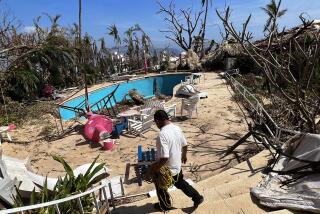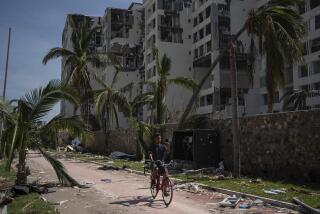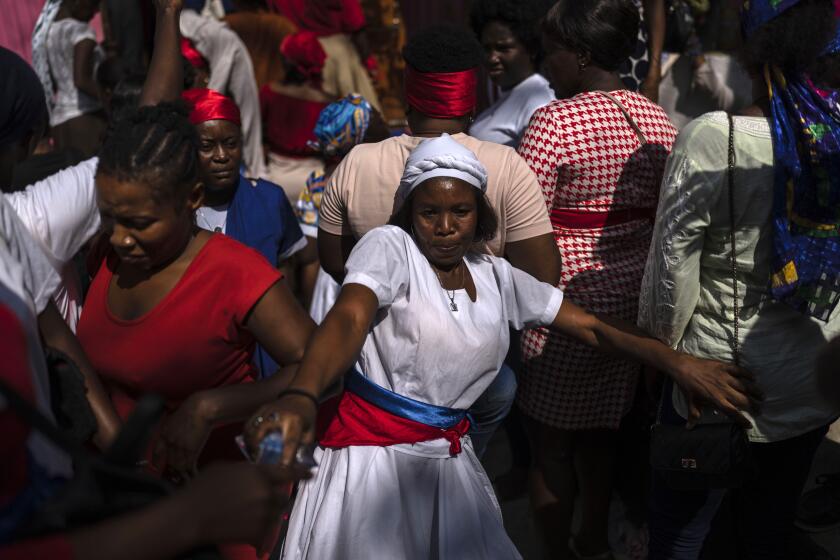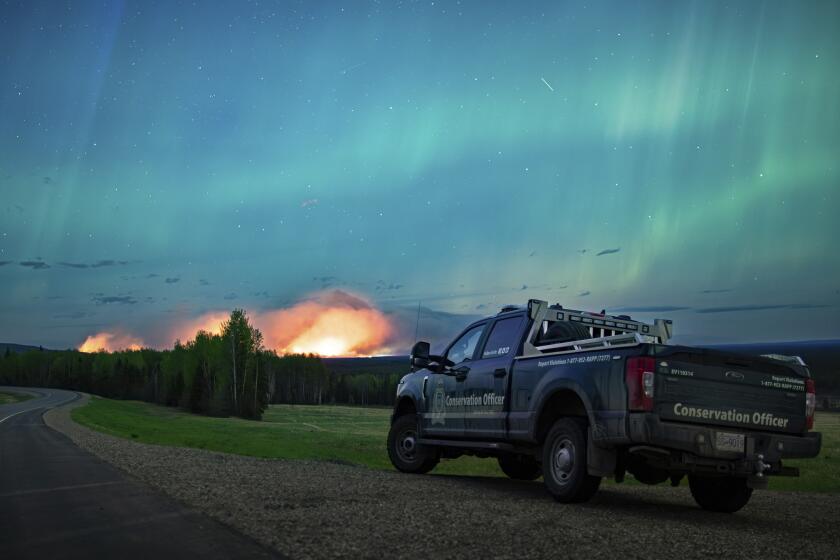Florida Suffers 2nd Blow From Hurricane Erin
Hurricane Erin snapped across Pensacola early Thursday like a whip, lashing Florida for a second day with spitting, roaring wind that wrecked buildings, cut off power to 700,000 people and left two dead and five lost at sea.
Erin ambushed tens of thousands who fled inland, some into its path. Winds of 94 m.p.h., with gusts up to 100 m.p.h., shattered windows in homes, restaurants and offices. The storm peeled roofs into strips of crinkled metal and exploded electrical transformers on power poles. Four floors of a hospital went without water.
The hurricane swept past Mobile, Ala., about 50 miles away. By late evening, it weakened and churned northwest at 13 m.p.h., said Robert Burpee, director of the National Hurricane Center in Miami. Its sustained wind dropped to 40 m.p.h. in rural Alabama, and it headed for southern Mississippi and central Louisiana.
Erin first struck Florida on Wednesday. It swept from Vero Beach on the Atlantic to Tampa on the Gulf of Mexico, killing two people and sinking a tugboat, a gambling ship and a raft. The tug crew was rescued, but three crewmen from the gaming ship were missing, as well as a man and his daughter on the raft.
Out in the Gulf, Erin veered slightly north. It hit Pensacola, on the Florida Panhandle, about 10 a.m. Thursday. By midday, state insurance officials predicted total losses as high as $200 million. Gov. Lawton Chiles asked President Clinton to declare a federal emergency to pave the way for disaster aid.
Florida is still recovering from Hurricane Andrew three years ago. Andrew struck the southern tip of the state with 145-m.p.h. winds, then blew across the Gulf and slammed into Louisiana. It killed 14 people and caused damages estimated at between $20 billion and $30 billion.
The three crew members of the gambling boat, the 234-foot Club Royale, were declared missing after it sank Wednesday 90 miles northeast of Cape Canaveral, as Erin lashed the east Florida coast. They were identified as the owner of the vessel, its captain and a cook. Eight other sailors managed to escape unharmed.
*
The Coast Guard identified the father and daughter on the raft as Frank Stadler, 44, and Megan, 9, of Thomaston, Ga. They were reported missing by Stadler’s wife at 3 p.m. Wednesday when they did not return from an outing on the Gulf off Cape San Blas, 15 miles west of Apalachicola, Fla.
Their raft was yellow, 12 feet long and inflatable. It had oars, authorities said, but neither the man nor his daughter wore a life jacket.
Before Erin hit the Panhandle, many coastal residents failed to take hurricane warnings seriously and were caught by surprise, state officials said. John Teelin, an Escambia County, Fla., emergency management official, said that only 2,500 to 3,000 people took refuge in shelters. He said the county did not have enough time to warn residents.
But officials at the National Hurrican Center said a hurricane warning was posted for the Panhandle at least 19 hours before Erin struck.
Roger Kinnard of Gulf Breeze, a small town south of Pensacola, said he, like most other residents, did not evacuate and did not prepare for the storm. Many thought Erin would pass by and strike land farther west. People fled nearby barrier islands, however, before the storm hit.
“If they had any sense,” Kinnard said, “they left.”
As wind began to pound Pensacola, fear came and went like a bad dream. A Holiday Inn on Pensacola Boulevard was fully booked with 500 guests. The staff struggled to keep people in their rooms.
“The guests from Florida are used to hurricanes,” said manager Penny Currier. “But other guests became panicky. We gave them instructions on how to tape their windows and take refuge in the bathroom if the hurricane got bad. But any time there was a break in the storm, they came out of their rooms.”
Mary Griewisch and her husband and two children fled their double-wide mobile home and watched the storm through the big windows of her mother’s house, built in 1957 by her grandfather out of cinder blocks and concrete.
“We’ve lost at least six trees and more are going,” she said by telephone as the hurricane hit. The trees were 100-year-old oaks and 60-year-old pines. “The eye went right over us. It went completely calm, with no sun, just a light breeze. That lasted about 20 minutes, and then it started right back up again, from the opposite direction.
“We’ve had gusts well over 100 m.p.h. It’s just really blowing right now,” said Griewisch, her voice breaking. “The children were really scared at one point, when the trees were falling steady, one after another. One tree fell over the front porch and flattened that. It hit part of the roof of the house, but the roof is not leaking.”
Power lines were broken throughout the neighborhood, she said, and some were hanging down. There was no electricity.
Griewisch’s husband outfits vans for handicapped drivers. Fearing that the vans might be damaged, he drove them out of his workshop and parked them in the middle of a seven-acre field, away from buildings and trees.
It was a good thing, his wife said. The storm turned the roof of his shop into wrinkled metal.
In part of Pensacola, the sun actually shined through the eye of the hurricane. “Then the other side of the storm came by,” said June Sasser, who lives north of the Pensacola airport. “It wasn’t as strong.”
*
Her son, Billy, was one of 30 employees on duty at a Monsanto chemical plant when Erin hit. His job was to see if any pipelines ruptured and spilled acid. “We had one line come off from the No. 3 reactor,” he said, “and we shut it down.”
As night fell, virtually all of Pensacola stayed dark. Hundreds of electrical lines had been broken by uprooted and shattered trees. The Escambia County Sheriff’s Department assigned more than 50 cars to patrol duty to guard against looting.
Authorities barricaded the hardest-hit parts of town.
Eighty-seven F-15 and F-16 jet fighters at Eglin Air Force Base, 50 miles east of Pensacola, were flown to other airfields to avoid the storm.
“The base is pretty much without power in the housing area,” said Sgt. Wes Ticer, referring to about 1,000 homes. “My family moved up to Montgomery [in Alabama] 170 miles north, but they’re probably getting heavy winds and rains up there too.”
At Sacred Heart Hospital in Pensacola, Patrick Schenker, a vice president of the hospital corporation, said the emergency room treated several people.
Because of problems with the Pensacola water system, he said, there was no pressure above the first floor. That left four floors without water. Schenker said staff members were carrying water to the upper floors to flush toilets.
“We’ve got a good bit of damage,” said Sandra Corcoran, vice president of nursing. “Lots of trees down. The hospital has power, one of the few places that does. We’ve had a few storm-related emergencies, some fractures, some minor lacerations and some people with chest pains. People get excited during hurricanes.”
Baptist Hospital in Pensacola suspended all elective surgeries and outpatient visits for the duration of the storm.
This was the first hurricane for Sgt. Dan Luoma, stationed at Hurlburt Field, an air base in Mary Esther, about 30 miles east of Pensacola.
He rode it out in his two-story home with his three teen-age children.
“We don’t have shutters, so we used a safe area on the ground floor,” he said. “We huddled together. The sheer power of nature was pretty intense.”
Harrison reported from Pensacola and Stanley from Atlanta. Also contributing to this story were researcher Anna M. Virtue in Miami and staff writer Richard E. Meyer in Los Angeles.
More to Read
Start your day right
Sign up for Essential California for news, features and recommendations from the L.A. Times and beyond in your inbox six days a week.
You may occasionally receive promotional content from the Los Angeles Times.






